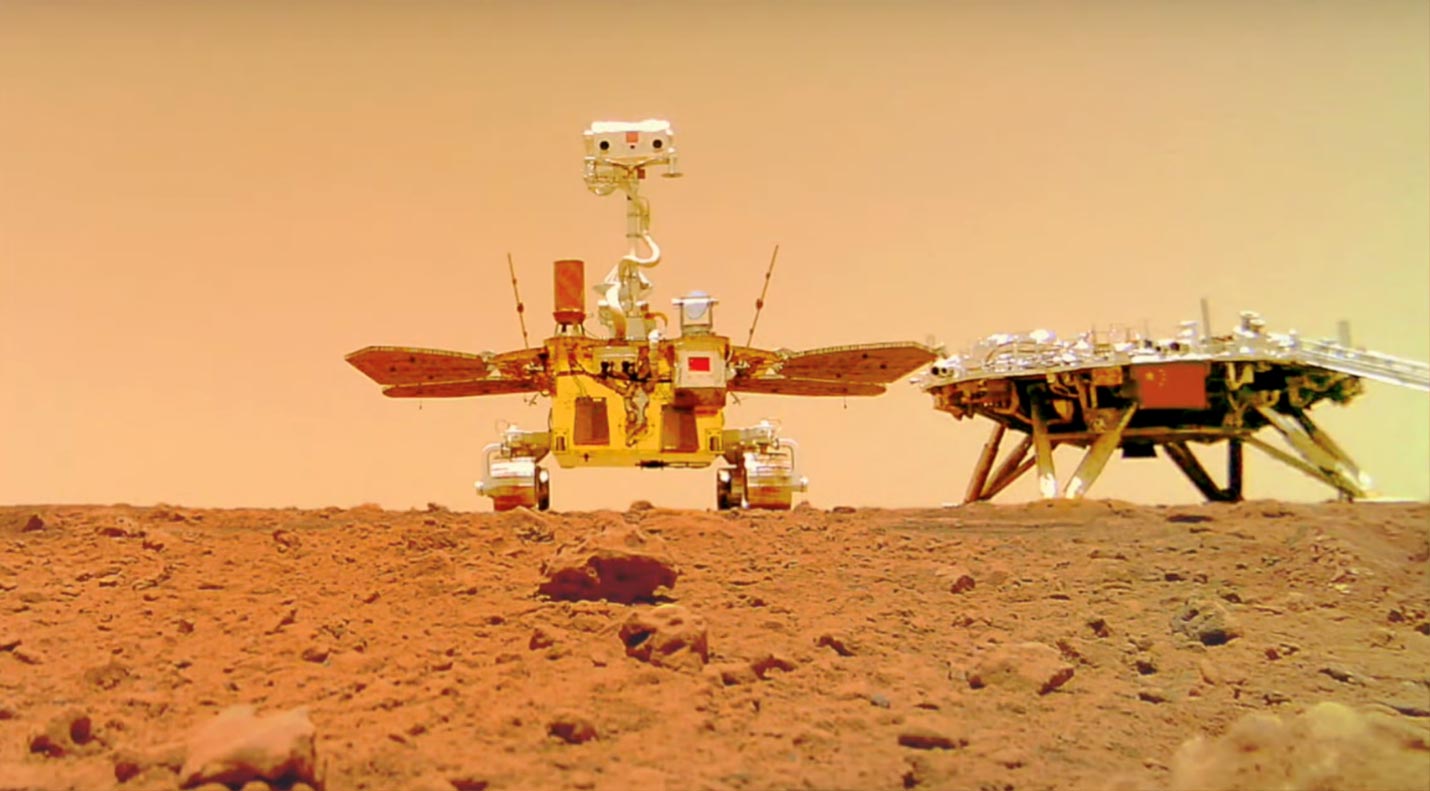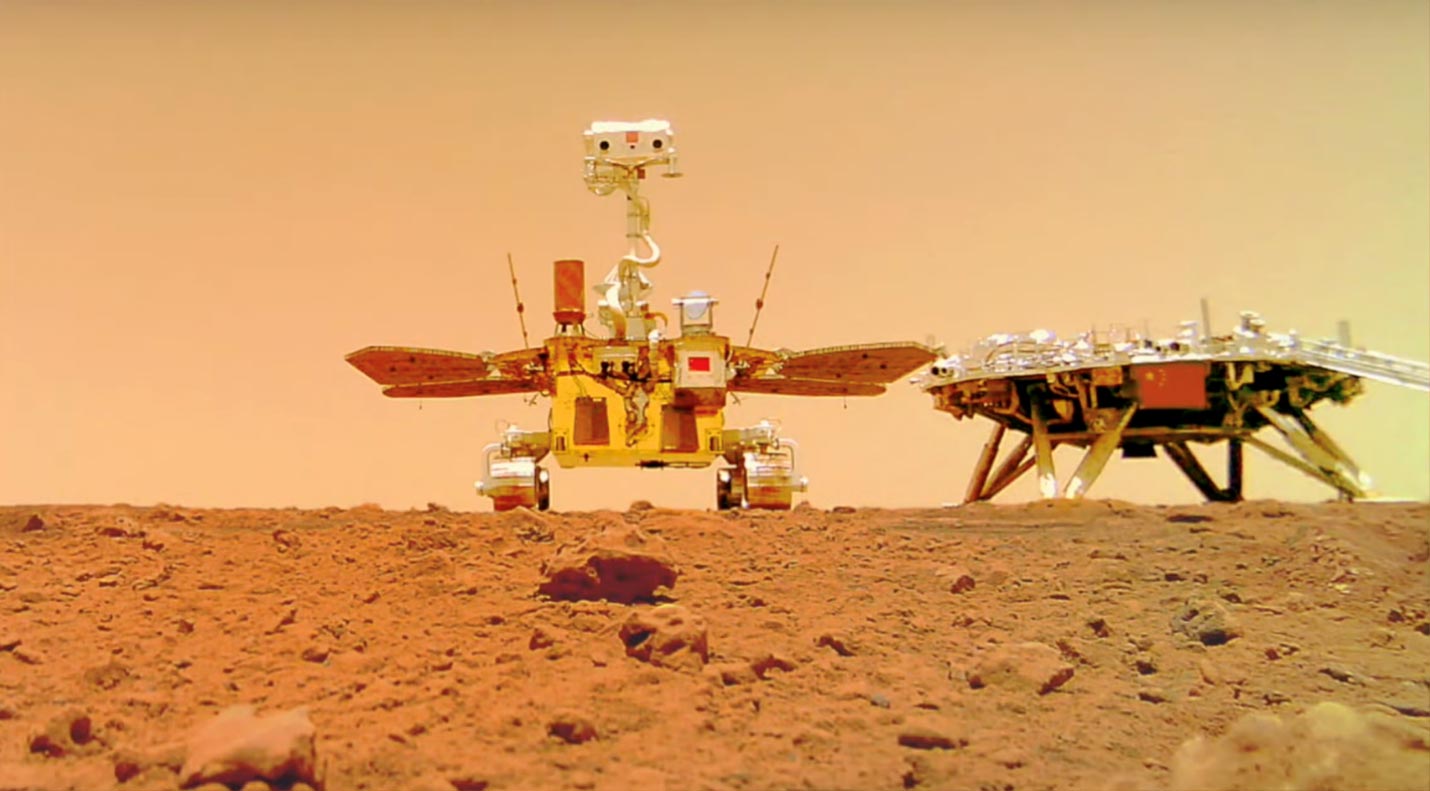
صورة سيلفي التقطتها العربة الجوالة Jurong وهي على منصة هبوطها ، والتُقِطت بكاميرا لاسلكية. الائتمان: إدارة الفضاء الوطنية الصينية
العربة الجوالة Zhurong ، وهي جزء من Tianwen-1 الصينية[{” attribute=””>Mars mission, has found evidence of liquid water at low Martian latitudes, indicating potentially habitable environments. This discovery, contradicting previous beliefs that water could only exist in solid or gaseous states on Mars, was made by analyzing morphological features and mineral compositions of dunes in the landing area.
The Zhurong rover has found evidence of water on dune surfaces on modern Mars by providing key observational proof of liquid water at low Martian latitudes, according to a study led by Prof. Xiaoguang Qin from the Institute of Geology and Geophysics (IGG) of the Chinese Academy of Sciences (CAS).
The study was published on April 28 in the journal Science Advances.
Researchers from the National Astronomical Observatories of CAS and the Institute of Atmospheric Physics of CAS were also involved in the study.

Water traces on bright sand dunes. (a) Topographic contour map of the environs where the trace is located. The coordinate system is east-north-up (ENU) local Cartesian coordinate and the origin is that of the rover coordinate system. The background Digital Orthophoto Map (DOM) photo was taken by NaTeCam. (b) MSCam bird’s-eye-view photo showing a strip-like trace and a likely water-soaked fragmented soil block. (c) Enlarged photo showing polygonal cracks and bright polygonal ridges. (d) Enlarged photo showing circular region with the strip-like trace as a part. (e) NaTeCam 3D image of an interdune depression between two dark longitudinal dunes. (f) A cross-section of the dune along the profile of the white dash line in (e). Credit: IGGCAS
Previous studies have provided proof of a large amount of liquid water on early Mars, but with the escape of the early Martian atmosphere during the later period, the climate changed dramatically. Very low pressure and water vapor content make it difficult for liquid water to sustainably exist on Mars today. Thus, it has been widely believed that water can only exist there in solid or gaseous forms.
Nonetheless, droplets observed on the Phoenix’s robotic arm prove that salty liquid water can appear in the summer at current high latitudes on Mars. Numerical simulations have also shown that climatic conditions suitable for liquid water can briefly occur in certain areas of Mars today. Until now, though, no evidence has shown the presence of liquid water at low latitudes on Mars.
Now, however, findings from the Zhurong rover fill the gap. The Zhurong rover, which is part of China’s Tianwen-1 Mars exploration mission, successfully landed on Mars on May 15, 2021. The landing site is located at the southern edge of the Utopia Planitia (UP) Plain (109.925 E, 25.066 N), where the northern lowlands unit is located.
https://www.youtube.com/watch؟v=wBe3yweYXns
استخدم الباحثون البيانات التي تم الحصول عليها بواسطة كاميرا الملاحة والتضاريس (NaTeCam) والكاميرا متعددة الأطياف (MSCam) وكاشف تكوين سطح المريخ (MarSoDe) على متن مركبة جورونج الجوالة. منطقة الهبوط.
ووجدوا بعض السمات المورفولوجية المهمة في أسطح الكثبان الرملية مثل التلال والشقوق والتحبيب والتلال متعددة الأضلاع وأثر يشبه الشريط. يُظهر تحليل البيانات الطيفية أن الطبقة السطحية للكثبان الرملية غنية بالكبريتات المائية والسيليكا المائية (خاصة أوبال- Cd) ومعادن أكسيد الحديد ثلاثية التكافؤ (خاصة فيريهيدريت) والكلوريدات.
“استنادًا إلى بيانات الأرصاد الجوية التي تم قياسها بواسطة Jurong ومركبات المريخ الأخرى ، افترضنا أن سمات سطح الكثبان الرملية هذه مرتبطة بتورط المياه المالحة السائلة المتكونة من ذوبان الجليد / الجليد الذي يسقط على سطح الكثبان الملحية أثناء التبريد ،” قال الأستاذ. تشين.
على وجه التحديد ، تتسبب الأملاح الموجودة في الكثبان الرملية في ذوبان الصقيع / الثلج في درجات حرارة منخفضة لتكوين مياه سائلة مالحة. عندما يجف المحلول الملحي ، ترسب الكبريتات المائية والأوبال وأكسيد الحديد والمعادن الرطبة الأخرى جزيئات الرمل في تجمعات الرمل والقشور. ثم تتشقق القشرة أكثر بسبب الضغط. تؤدي عملية التجميد / الذوبان اللاحقة أيضًا إلى إنشاء حواف متعددة الأضلاع وآثار تشبه الشريط على سطح القشرة.
يشير العمر التقديري للكثبان (حوالي 0.4-1.4 مليون سنة) والعلاقة بين المراحل الثلاث للماء إلى أن بخار الماء قد تحول من الجليد القطبي باتجاه خط الاستواء خلال التدرجات العظيمة في أواخر فترة الأمازون على المريخ. تكرار البيئات الرطبة عند خطوط العرض المنخفضة. لذلك ، تم اقتراح سيناريو للنشاط المائي ، أي أن التبريد عند خطوط العرض المنخفضة أثناء التدرجات الكبرى للمريخ يؤدي إلى تساقط الصقيع / الثلج ، مما يؤدي إلى تشكل القشور والتجمعات على سطح الكثبان الملحية ، وبالتالي تصلب الكثبان وتترك آثارًا. نشاط الماء المالح السائل.
يوفر هذا الاكتشاف أدلة رصد رئيسية للمياه السائلة في خطوط العرض المنخفضة للمريخ ، حيث تكون درجات حرارة السطح أكثر دفئًا نسبيًا وأكثر ملاءمة للحياة منها في خطوط العرض العالية.
قال البروفيسور تشين: “هذا مهم لفهم التاريخ التطوري لمناخ المريخ ، والبحث عن بيئة صالحة للسكن ، وتقديم أدلة مهمة للبحث في المستقبل عن الحياة”.
المرجع: “المياه الحديثة عند خطوط العرض المنخفضة على سطح المريخ: أدلة محتملة من أسطح الكثبان الرملية” Xiaoguang Qin، Xin Ren، Xu Wang، Jianjun Liu، Haibin Wu، Xingguo Zeng، Yong Sun، Zhaopeng Chen، Shihao Zhang، Yizhong Zhang، Wangli Chen، Bin Liu و Dawei Liu و Lin Guo و Konggang Li و Xiangzhao Zheng و Hai Huang و Qing Zhang و Changsheng Yu و Chunlai Li و Zhengdong Guo ، 28 أبريل 2023 ، التقدم العلمي.
DOI: 10.1126 / sciadv.add8868

“متعصب للموسيقى. مستكشف متواضع جدا. محلل. متعصب للسفر. مدرس تلفزيوني متطرف. لاعب.”

